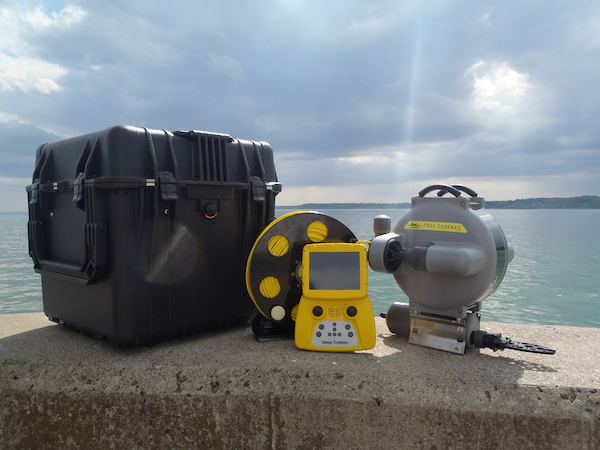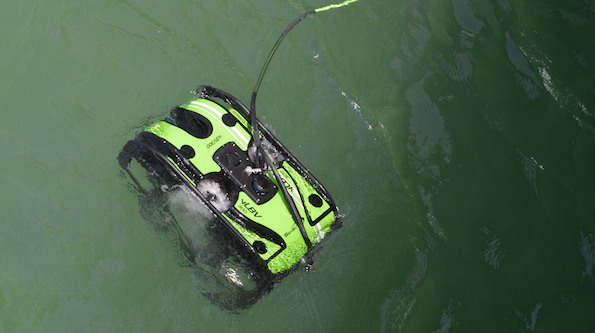ROVs: toy and tool
Considering their applications, both practical and as a toy, remotely operated vehicles (ROVs) are still relatively uncommon on board superyachts. What can these mini-subs do and should you add one to your superyacht toy box?
Essentially a remote control underwater camera drone, ROVs are controlled from the surface and able to do everything from inspecting the hull to filming the seafloor. Add the right appendages and it can pick things up or even saw.
Canadian ROV specialist Deep Trekker has been selling ROVs since 2010 and currently has two product lines, the G2 and the X2. Carefully put together and tested in Ontario by z team of skilled engineers and technologists, each submersible is made from die-cast aluminium that has been anodised and powder coated for durability in salt and fresh water. While 85 to 90 per cent of Deep Trekker’s sales at the moment are to the commercial sector, its ROVs are becoming increasingly popular with recreational users, in particular superyachts.
“There aren’t that many superyachts that have ROVs yet,” admits Josh Richardson, managing director of Superyacht Tenders and Toys which has only supplied around five top end ROVs to superyachts to date. “They’ve been used mainly for commercial purposes so far, quite popular for surveying, search and rescue and scientific research, but as a superyacht toy they are also fun and actually very useful.”
According to Amanda Coulas of Deep Trekkers, the primary recreational clients are yacht owners, treasure hunters and fishermen. “ROVs are great for yacht owners who are interested in exploring the reefs, watching their family dive or finding new diving sites for themselves,” she says. “Ours are totally grab-and-go since each one is in its own carrying case. It is battery operated so it doesn’t plug into the boat anywhere. It is really simple.”
Paul Allen's treasure-hunting M/Y Octopus has its own ROV to aid in exploration and research, which it most recently used to find and explore the wreck of Japanese warship Musashi. Capable of going down to around 27km, the Octopus ROV has been nicknamed OctoROV by the crew and has a camera that can produce broadcast-quality video. In the past it has been used to capture footage for a documentary to study the effects of nuclear detonation on the marine environment with the Discovery Science Channel and on the Royal Navy’s quest to recover the bell from the wreckage of the HMS Hood.
They don’t have to be used by only serious archaeological hunters though. Last year Superyacht Tenders and Toys supplied a Seabotix ROV to an owner’s son for his birthday. "An owner last year wanted a gift for his son’s birthday so he bought him an ROV," says Richardson. “He was sending me pictures of him picking up bottles from the sea floor, nothing exciting, but he loves it. Just imagine sitting on the aft deck, drink in hand with your feet dangling in the water watching what is happening 300m below you on a screen ... it is quite cool isn’t it?”
ROVs can also help perform yacht maintenance. “Captains like the device due to the low maintenance, and the ability for them to quickly inspect the hull without bringing the boat out of the water and having a diver,” says Coulas. “In 30 seconds you can have eyes on the hull, so rather than taking the time and effort to send a diver down, they can see what is happening really quickly. It is faster, much safer. In the middle of the ocean you can see the problem and if you need to inspect an issue in port, you don’t need to pay someone to inspect it.” Richardson adds that some ROVs can be fitted with a CO2 to allow them to lift an anchor from the bottom of it has become stuck.
"We actually supplied one to a superyacht in Greece so that they could survey the hull, not for maintenance, but for security purposes," says Richardson. "They'd had a bomb scare where they had to send in crew members to dive down to the hull to check, so they purchased it so that in future they wouldn't have to send crew members down to look at the hull."
For the Deep Trekker ROVs no training is required, they are intuitive and straightforward to use ("12-year-olds are find them particularly easy to use as they are like a Playstation controller," says Coulas) but for the more expensive Seabotix models, Richardson recommends some training time. Commercial operators will complete a two-day training course but superyacht clients will need a couple hours at least to get to grips with all that these machines can do.
For a relatively superyacht-friendly ROV you can expect to pay from USD 3,900 up to the top end USD 50,000 Seabotix., and all additional pieces of kit - grabbing arms, HD video, saws, etc - are extra.
NEW: Sign up for SuperyachtNewsweek!
Get the latest weekly news, in-depth reports, intelligence, and strategic insights, delivered directly from The Superyacht Group's editors and market analysts.
Stay at the forefront of the superyacht industry with SuperyachtNewsweek
Click here to become part of The Superyacht Group community, and join us in our mission to make this industry accessible to all, and prosperous for the long-term. We are offering access to the superyacht industry’s most comprehensive and longstanding archive of business-critical information, as well as a comprehensive, real-time superyacht fleet database, for just £10 per month, because we are One Industry with One Mission. Sign up here.
NEW: Sign up for
SuperyachtNewsweek!
Get the latest weekly news, in-depth reports, intelligence, and strategic insights, delivered directly from The Superyacht Group's editors and market analysts.
Stay at the forefront of the superyacht industry with SuperyachtNewsweek





